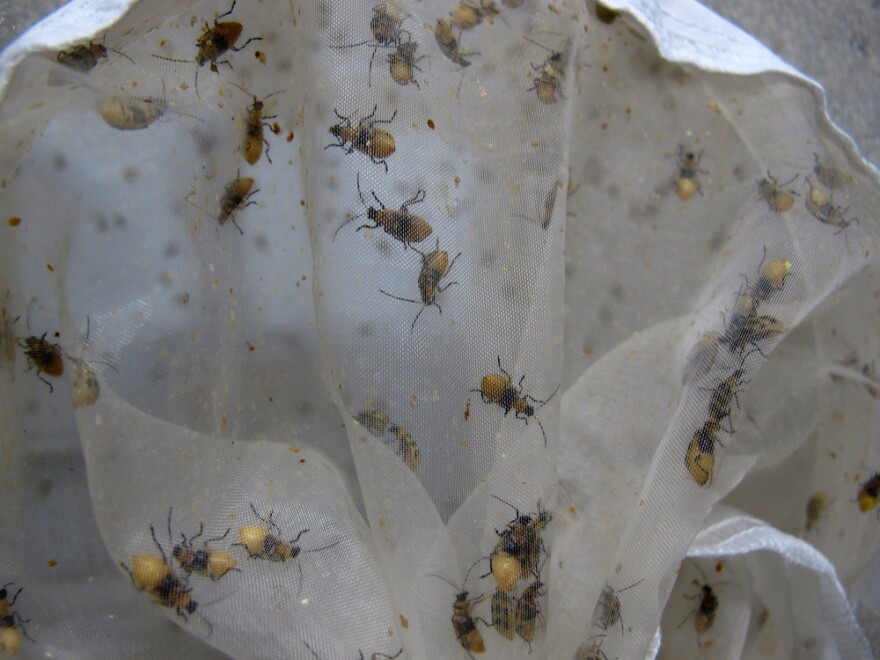With rootworms building resistance to genetically modified corn that makes its own pesticide, seed companies are working on new crops that target the insects’ genes. But some worry about unintended consequences when the technology moves from the lab to the field.
Rootworms are a constant nemesis of farmers in Nebraska and across the Midwest. Their larvae feed on the roots of corn plants. A decade ago, researchers developed Bt corn – corn genetically modified to produce a protein that kills the bugs, allowing farmers to back off chemical pesticides. But like every other pesticide that’s been tried against rootworms, the effectiveness of Bt corn is beginning to wear off, leading farmers across the Corn Belt to go back to chemicals that can be harmful to humans and wildlife.
Seed companies are preparing a new solution: RNA-interference, sometimes called gene silencing. Researchers using the technology introduce a strand of RNA that essentially stops an organism ingesting the molecule from expressing a certain gene.
Genes are expressed through RNA that are transcribed from DNA. But if you introduce a piece of interfering RNA, a gene can be suppressed. RNA-interference, or RNAi, is a natural way plants and animals fight off viruses, but scientists use it as a genetic on/off switch to study and manipulate plants.
Tom Clemente, a researcher in plant biotechnology at the University of Nebraska Lincoln, says RNAi was discovered in plants when researchers were trying to make flowers darker.
“They were trying to make a darker, purple flower and they were getting white flowers,” Clemente said. “They were trying to make more of this protein and they were making zero of the protein.”
Now, RNAi is being studied to treat human diseases from cancer to high cholesterol. RNAi crops are already in the field.
“The classic example is for virus resistance,” Clemente said. “In the state of Hawaii the entire papaya population is papaya ringspot virus (resistant) and it is a form of RNAi that provides that resistance.”
But corn could be the first crop to attack an invading insect with RNA. For instance, Monsanto hopes to commercialize rootworm resistant corn with RNAi by the end of the decade. When a rootworm eats the corn roots, it would ingest interfering RNA that would silence a gene the rootworm can’t live without.
“It blocks expression of that particular gene – no other gene – and impedes the life cycle of that rootworm,” Clemente said.
But Jon Lundgren, an entomologist at a USDA research lab in Brookings, S.D., says regulators should evaluate RNAi crops with caution. He is looking at whether RNAi aimed at one insect could have off-target effects on other insects, like bees or butterflies.
“Where else in the genome is going to be silenced inadvertently, and what effects is that going to have on the function of our natural biological systems?” Lundgren asked.
When one gene is silenced by interfering RNA, Lundgren says, sometimes a completely unrelated gene is altered in unpredictable ways, and that needs more consideration before these crops move from the lab to the field.
“Our really poor knowledge of genomes within most organisms, nearly all organisms, really begs the question of how we’re going to predict all of these potential effects,” Lundgren said.
That question goes to the Environmental Protection Agency. At a meeting in January, scientists from around the world will advise the EPA on how to assess the potential risks of RNAi crops.
For his part, Tom Clemente doesn’t believe the technology warrants extra scrutiny.
“You can dial it in to be very specific for a gene in a particular organism,” Clemente said. “Now, we can never say with a straight face that would mitigate any collateral damage in any other organism. But you can mitigate that probability to a very, very small number.”
Clemente says, when paired with Bt in corn, RNAi would give farmers a more durable weapon against rootworms. What regulators may want to know is if they can be sure it’s safe for the other bugs that call a cornfield home.



